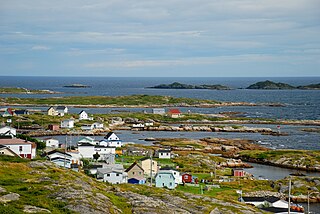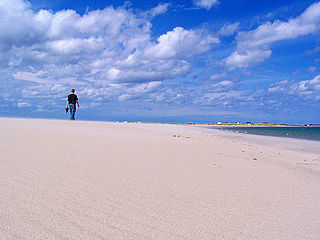Newtown is a part of the Municipality of New-Wes-Valley, located at the North end of Bonavista Bay in the province of Newfoundland and Labrador, Canada. The approximate population is 400. Settlement in Newtown originated around 1850 when people relocated from nearby areas. Newtown is well known for being built on many small islands, and is the home of the Barbour Living Heritage Village.

Bonavista North was a provincial electoral district for the House of Assembly of Newfoundland and Labrador, Canada. It existed from when Newfoundland joined confederation in 1949 until 2015.

Greenspond is a community in the province of Newfoundland and Labrador, Canada.
Safe Harbour is an abandoned outport on the northeast coast of Newfoundland in the Canadian province of Newfoundland and Labrador. Settled by 1870, it was abandoned in 1955.
Templeman is a community of New-Wes-Valley in Newfoundland, Canada, located on the north side of Bonavista Bay just south of Cape Freels and north of Wesleyville. Templeman has a shallow and rocky harbour, and can only accommodate small boats.
Valleyfield, Newfoundland is a village and was served by the C.N.R. It joined the Rural District of Badger's Quay-Valleyfield-Pool's Island in April 1980 until 1992 when the District merged with other nearby towns to form New-Wes-Valley. Valleyfield has a good harbour, and is the location of the Beothic Fisheries fish plant.
Badger's Quay is a Canadian town in the province of Newfoundland and Labrador.
Musgrave Harbour is a town in the Canadian province of Newfoundland and Labrador.
New-Wes-Valley is a municipality in Newfoundland and Labrador, Canada.
Cape Island is the name of both an island and a former community in the Canadian province of Newfoundland and Labrador.
Deadman's Bay is a local service district and designated place in the Canadian province of Newfoundland and Labrador. It is on the Straight Shore of Bonavista Bay near the community of Lumsden. The community is located near fishing grounds, contributing to its diversified and successful fishery despite its exposed, sandy coastline and harsh fall storms.
Flowers Island was one of the communities in an area on the northeast coast of the Island of Newfoundland called Bonavista North. These communities have a shared history in that they were settled by people from England, predominantly from the West Country—Dorset, Devon Somerset and Hampshire.
Cape Freels is one of the communities that comprise an area on the northeast coast of the Island of Newfoundland, called Bonavista North, in the province of Newfoundland and Labrador, Canada. These communities have a shared history in that they were settled by people from England, predominantly from the West Country - Dorset, Devon, Somerset and Hampshire.

Lumsden, formerly known as Cat Harbour, is a community located on the Straight Shore of Newfoundland in Newfoundland and Labrador, Canada, near communities such as Musgrave Harbour and Newtown. Lumsden formerly consisted of two settlements, Lumsden North on the tip of a sandy peninsula and Lumsden South on the main road. Although the harbour in Lumsden is not ideal because it is not sheltered, Lumsden has excellent fishing grounds.
Ladle Cove is a designated place in the Canadian province of Newfoundland and Labrador. It is along the Straight Shore on the island of Newfoundland.
Pool's Island is an incorporated community of Badger's Quay-Valleyfield-Pool's Island in the province of Newfoundland and Labrador, Canada. It is now part of the town of New-Wes-Valley.
Swain's Island, Newfoundland, is actually a group of eight islands on the north side of Bonavista Bay, southeast of Wesleyville. All of these islands once had inhabitants but eventually all of them were resettled, mostly to Wesleyville.
Located on the northwest side of Bonavista Bay, Newfoundland at the mouth of the Indian Bay inlet is a small island named Silver Fox Island that was once inhabited. It is about 3 km in length and about 3 km from Fair Island. The first settling began at Warren's Harbour on the southern side of the island.
Pinchard's Island was one of the communities that comprise an area on the northeast coast of the Island of Newfoundland, called Bonavista North. These communities have a shared history in that they were settled by people from England, predominantly from the West Country - Dorset, Devon Somerset and Hampshire.
Naboth Winsor was born to Robert Stewart Winsor and Jane (Butt) Winsor, on Winsor's Island, one of the islands comprising Swain's Island, Bonavista Bay, Newfoundland. Winsor and his family moved to nearby Wesleyville when he was four years old. Winsor received a Bachelor of Arts Degree, the Degree of Master of Divinity, and a Master of Arts Degree. He was an Ordained United Church Minister, and later, an author. Winsor was a United Church Minister for forty-four years, and he wrote several books on certain aspects of Newfoundland History, primarily on areas in Bonavista Bay, Newfoundland.



